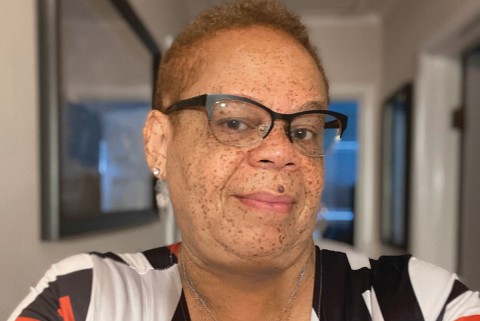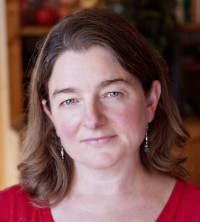Centering the sacred work of spiritual direction for people of color
“Breath is how I bring myself back to God. My breath is my sacred word.”

Therese Taylor-Stinson is the managing member of the Spiritual Directors of Color Network, Ltd., which she founded in 2008. The group has produced three books: Embodied Spirits, Ain’t Gonna Let Nobody Turn Me Around, and most recently, Kaleidoscope: Broadening the Palette in the Art of Spiritual Direction, a curriculum that centers the experiences of spiritual directors of color. Taylor-Stinson has been involved in spiritual guidance for more than 15 years and is a graduate of the Shalem Institute in Washington, DC.
How did you turn to spiritual direction?
When I first entered the Presbyterian Church (USA), I was trying to find a way to connect to the community. I saw a flyer about a prayer group that was starting. When I was little I sat with my grandmother praying, so this seemed like something I could get into. I didn’t realize that the couple leading the group had started it because the husband had been diagnosed with terminal cancer. He seemed very vital to me, and we became friends.
The experience of praying for someone over two years, watching him become very ill and die, was devastating to me. The others could have been devastated as well, but I couldn’t tell. They went on as before. I couldn’t go on. That sent me into a crisis. I had thought of myself as a great pray-er. I questioned my life, my faith journey, and where I was headed. I wasn’t sure who God was, much less Jesus. I was silenced. It became a very dark and desolate time in my young adult life.
Yet sometimes, when I was distressed, the only word I could say was “Jesus.” This was the beginning of my healing journey, my deep dive into the contemplative.
One day, in a bookstore, I saw a book entitled Spiritual Friend, written by Tilden Edwards, and I thought, “This is just what I need right now.” I took the book home and started reading it, and I learned that there was a place called Shalem right here in my own city. Who knew?
I called Shalem and asked about finding a spiritual director. I was invited to come to an open house, and I did. Even though I ended up finding a spiritual director through another means, this was the beginning of my relationship with Shalem and spiritual direction. Slowly it changed my life and my walk with the Divine.
How did you come to found a network for spiritual directors of color?
Many years later, I entered the Shalem spiritual guidance program to become a spiritual director myself. The program seemed very White. There was only one other person of color, another African American woman, in the cohort. This was usual for Shalem. I was often the only person of color in the events or programs Shalem offered. I was nonetheless fed by the content.
In the spiritual guidance program, none of the readings were written by people of color. By the end of the program, I decided to explore how what I was learning about spiritual direction and contemplative practice fit into the Black contemplative and mystical experience. I had to work hard to find books that spoke to the Black spiritual experience. Through this process I found Barbara Holmes, and I was also introduced to Franciscan nun Thea Bowman. My final paper was challenged by my assigned White mentor as “not contemplative.” Meanwhile, other readers said, “You need to publish this.”
I had a conversation with the only other African American woman in the program about why we were the only two seeking this formation as spiritual directors. That conversation led us to Spiritual Directors International’s educational event in 2008. We convened a networking table and invited every person of color we could find. That really opened my eyes to the diversity. There were Asians and people from Latin countries, as well as African Americans and Africans. When we asked around the table, “Why are you here?” the answer was the same: “Because I am wondering where the other people like me are who are having this experience.”
How did you start writing about Harriet Tubman as a mystic?
When Barbara Holmes wrote the foreword for Embodied Spirits, she started with a quotation from Harriet Tubman. It reads, “If you hear the dogs, keep going. If you see the torches in the woods, keep going. If there’s shouting after you, keep going. Don’t ever stop. Keep going. If you want a taste of freedom, keep going.” After reading that, the tears came. I saw and understood Harriet Tubman in a new way. I realized that she could not have done what she did if she did not have internal freedom. She acted in spite of the consequences because she had found that place of freedom inside herself.
In Jesus and the Disinherited, Howard Thurman writes, “If you cannot find the genuine in yourself, you will always be on the strings that someone else pulls.” Mama Tubman found the genuine in herself, and it allowed her to do things nobody else could have done.
You’ve also explored the landscape of Harriet Tubman, along with her inner life.
She’s become one of my muses, and I think about her in relation to my own internal freedom. Sometimes when my husband and I are driving along the highway and I look into the woods, I imagine my ancestors running through the woods to freedom. I don’t know how they did that. Uneven terrain. Swampy areas. Timberwolves, snakes. Not to mention slave catchers. There is a story of Harriet Tubman helping her brother to freedom. He gets overwhelmed by fear and says, “I can’t do this.” She puts a gun to his head and says, “Be free or die.”
One of the reasons she was able to do that was because she was underestimated by her enslavers. She was small; she had narcolepsy; she couldn’t read or write. Since she had been given the name Moses, the enslavers were looking for a man. They couldn’t imagine a person of her stature, with a brain injury, uneducated, being able to find her way to freedom alone, much less free a thousand more! And I couldn’t imagine it either until I made the connection with this idea of internal liberation.
What is sacred activism, and how is it related to contemplation?
Sacred activism is an act of the spirit. It is moving with intention in a way that aligns us with holy or divine purpose.
What’s the role of breath in that?
Breathing is part of my practice. Breath is how I bring myself back to God. For me, my breath is my sacred word.
When my uncle was dying of esophageal cancer, I went to sit with him at his home while my aunt went to church and had brunch with her friends. I thought that he wouldn’t want to talk, so I brought books and Christmas cards I wanted to write. Instead of sleeping, as I had imagined, my uncle sat in a chair for hours, and we had a marathon spiritual direction session.
I thought of him as being a “corny” Christian. He went to a Missionary Alliance church. A lot of their songs are like camp songs. So in my judgment, I thought of them as corny. On this day, I realized there was no separation between me and my uncle. He said to me, “Every breath I take is my prayer.” Ever since, I have thought the same: every breath I take is my intention for God.
My crisis had silenced me, but through my breath I have found my way back. Sometimes people say, “Pray for me,” and I have to find words, but for me, words are the least dense prayer that I know.
How might sacred activism help us navigate this particular political and social moment?
If we were to take seriously living in the Divine image, as we’ve been called to do since the beginning, we would understand everything that has happened thus far as reasons to pay attention. That is the main advice of the abbas and ammas of the desert: “Pay attention.”
When I observe nature, I see that to get from one season to another there is conflict. Without that conflict, there would be no seasons, no sustenance for life on the planet. The flowers that grow: their seeds have to be buried in the ground and break open to bring up from the ground new life. Or with these wildfires in the West: it is the nature of this territory to burn. Unless we learn how to live with these natural elements, we won’t do well. There has to be some kind of struggle to sustain life.
This dying and rebirth also goes on within us. I’ve heard it said that we are small universes. All of those life-sustaining events go on within us. I used to be terribly devastated by the pain I suffered. I’ve learned, however, that if I want to thrive, if I want to help other people, I have to first learn to love myself and to help myself be patient with and understand the life process that is going on inside me. Then I can recognize it in others.
A version of this article appears in the print edition under the title “Breathe, pray, act." For more on Therese Taylor-Stinson, listen to her conversation with Cassidy Hall on the Contemplating Now podcast.





